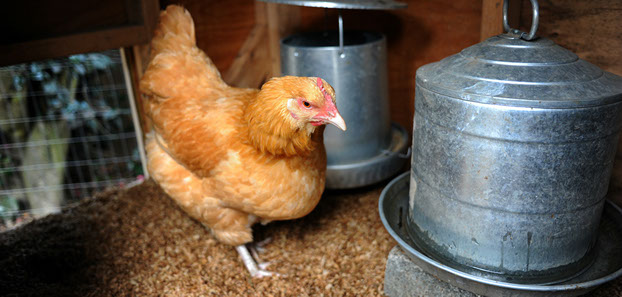One of the most common problems that is faced when raising poultry is that of mites. There are several different types of mites that can infest flocks and poultry housing. These mites can result in production and economic losses as well as eventual death if the problem goes unresolved.
These mites can come from many different sources. Wild birds and rodents entering the coop may bring them in or they may be picked up at sales, auctions or shows where many birds are in close contact.
Chicken mites are the most common type that may infest your flock. Chicken mites are nocturnal and feed on the bird’s blood while they sleep at night. They are tiny and yellow or gray in color however they get darker as they feed. Chicken mites live on the skin of birds as well as in nest boxes and bedding. While they prefer chickens as their host, chicken mites may also infest turkeys, pigeons, canaries as well as wild birds. Chicken mites are also known as red mites, gray mites and roost mites. They are a particular problem in warmer climates and in poultry houses that contain wooden roosts. An infestation may cause your birds to become anemic and lethargic with pale comb and wattles.
Chicken mites are considered to be members of the spider family. They are very quick runners and live in the cracks and crevices of poultry houses, on the roosts, walls, ceiling, and floors. The spring, summer and fall months are when these mites are most active.
The most effective way to get rid of these mites is to treat the coop rather than the birds themselves. In fact, you may never see these mites on your birds unless they are examined at night.
Northern fowl mites are another common type of mite. These parasites infect many types of birds including chickens, turkeys and game birds and are thought to be carried by English sparrows. They live directly on the birds and will feed at all times. They are red/brown in color and will cause discoloration of a birds’ feathers. This discoloration is due to the eggs and waste that is left by the mite. If a flock is highly infested the birds may experience anemia leading to decreased egg production, decreased immune functioning, weight loss and many other negative side effects. Infestations may be found to be more severe during the winter months.
Treatment of the birds themselves is most effective for getting rid of these types of mites.
Scaly leg mites may also pose a threat to your poultry. These mites live on the scales of a chickens legs and feet. The scales will begin to lift and separate from the skin. The chickens legs and feet may become swollen and tender and discharge may form under the scales.
Another problem that is faced by poultry farmers is lice. Unlike mites, lice do not feed on blood but rather on dry skin scales and feathers. They have chewing mouth parts rather than the sucking mouth parts possessed by mites. Lice can be found on the skin of a bird, especially on the head, under the wings and around the vent. The chewing action of the lice as well as their movement on the skin will irritate the bird and can result in loss of appetite, weakness, lowered egg production, and susceptibility to illness.
In the case of both lice and mites, untreated birds may exhibit symptoms such as weakening, loss of appetite, emaciation, lowered egg production, lethargy, and even eventually death. It is therefore important to constantly monitor your flock and to immediately treat your birds as soon as signs of an infestation occur.
A minimum of 10 randomly selected birds should be examined for mites weekly. You can estimate the infestation level by blowing on the bird’s feathers and counting the mites you see.
If there are:
- 5 mites counted = bird may be carrying from 100 to 300 mites
- 6 mites counted = bird may be carrying from 300 to 1,000 mites (light infestation)
- 7 mites counted = bird may be carrying from 1,000 to 3,000 mites – small clumps of mites seen on skin and feathers (moderate infestation)
- 8 mites counted = bird may be carrying from 3,000 to 10,000 mites – accumulation of mites on skin and feathers (moderate to heavy infestation)
- 9 mites counted = bird may be carrying 10,000 to 32,000 or more mites – numerous large clumps of mites seen on skin and feathers; skin pocketed with scabs (heavy infestation)
When treating for mites it is important to apply treatment to both the coop and the birds themselves. This is due to the fact that, unlike lice, some mites are able to live both on and off of their host.
A variety of treatments and preventative measures are currently available. Pesticides are a common method of treatment however mites and lice can become immune to these pesticides and therefore the technique will no longer be effective. Diatomaceous earth (such as DE-cide) may be a solution that will not become ineffective over time.
Image by furtwangl



